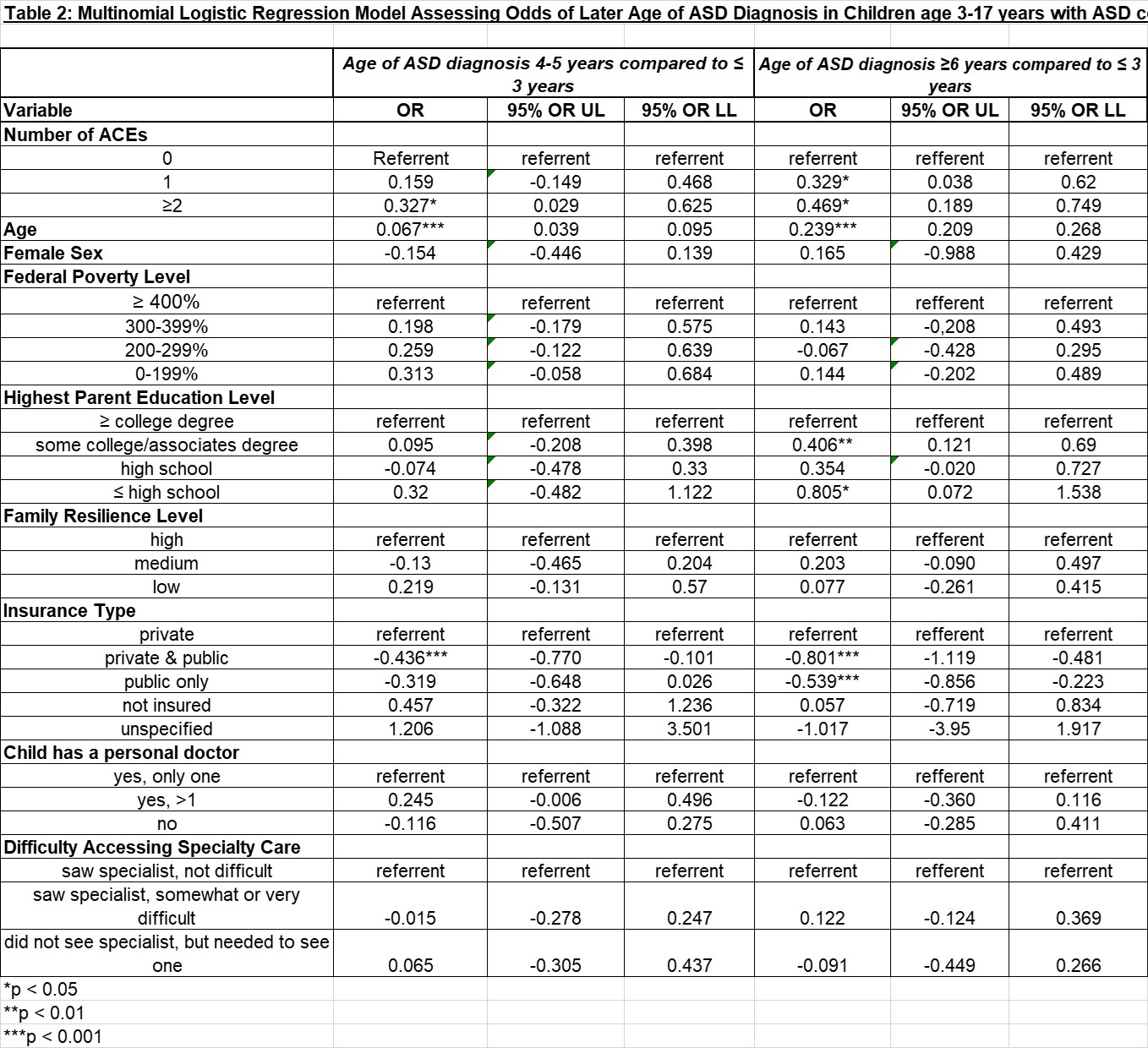Developmental and Behavioral Pediatrics 5: Autism 2/Other
Session: Developmental and Behavioral Pediatrics 5: Autism 2/Other
809 - Impact of Number of Adverse Childhood Experiences on Age of Autism Spectrum Disorder Diagnosis in a Nationally Representative Sample of Children age 3-17 years with Autism Spectrum Disorder
Saturday, April 26, 2025
2:30pm - 4:45pm HST
Publication Number: 809.5117
Mary-Elizabeth A. Calabrese, Inova Children’s Hospital, Dumfries, VA, United States; Lorin A. Ferris, Inova Children's Hospital, Arlington, VA, United States

Mary-Elizabeth A. Calabrese, DO, MPH
Attending physician
Inova Children’s Hospital
Dumfries, Virginia, United States
Presenting Author(s)
Background: Autism Spectrum Disorder (ASD) is a common neurodevelopmental condition affecting 1 in 36 children. Early diagnosis and therapy initiation leads to significant improvement in functioning across domains. Adverse childhood experiences (ACEs) are a categorization of traumatic events or environmental factors that undermine a child’s sense of safety and stability and are implicated in suboptimal health outcomes. Children with ASD are more likely to experience ACEs, and higher numbers of ACEs, than their typically developing counterparts. The relationship between the number of ACEs and timing of ASD diagnosis is underexplored.
Objective: investigate if higher number of ACEs is associated with a later age of ASD diagnosis in children age 3-17 years.
Design/Methods: This is a secondary analysis of cross-sectional data from the 2016-2021 National Survey of Children’s Health, a nationally representative survey of caregivers of children 0-17 years old. Inclusion criteria were parent-reported current ASD diagnosis in children 3-17-years. ACEs were categorized as experiencing 0, 1, or ≥ 2. The primary outcome was age of parent-reported ASD diagnosis, categorized as age ≤ 3, 4-5, and ≥ 6 years. Multinomial logistic regression examined association between number of ACEs and age of ASD diagnosis, controlling for confounding variables (demographic, individual, and family factors, measures of healthcare access).
Results: 5815 children with ASD age 3-17 years were included. 2291 (42.6%) were diagnosed with ASD at ≤ 3, 1210 (22.5%) at 4-5, and 1879 (34.9%) at ≥ 6 years. Children diagnosed with ASD at age ≤ 3 , 4-5, and ≥6 years significantly differ on many covariates (Table 1). After controlling for demographic, individual, family, and health system factors, compared to children diagnosed with ASD at ≤ 3 years: children with 1 ACE were not more likely to be diagnosed at age 4-5 (OR 0.159, 95% CI -0.149-0.468) and more likely to be diagnosed ≥ 6 years (OR 0.329, 95% CI 0.038-0.620); children with ≥ 2 ACEs were more likely to be diagnosed at age 4-5 years (OR 0.327, 95% CI 0.029-0.625) and ≥ 6 years (OR 0.469, 95% CI 0.189-0.749) (Table 2).
Conclusion(s): While effect sizes are small, findings suggest higher number of ACEs is associated with an older age of ASD diagnosis. Early identification and intervention for ASD and ACEs is crucial to mitigate long-term impact of the intersectionality of disability and ACEs on child development and functioning. Further research should elucidate mechanisms underlying this relationship and inform targeted interventions for early detection and support for children with ASD and ACEs.
Table 1: Summary Statistics of Children with Parent Reported Autism Spectrum Disorder
.jpg)
Table 2: Multinomial Logistic Regression Model Assessing Odds of Later Age of Autism Spectrum Disorder Diagnosis in Children age 3-17 years with ASD

Table 1: Summary Statistics of Children with Parent Reported Autism Spectrum Disorder
.jpg)
Table 2: Multinomial Logistic Regression Model Assessing Odds of Later Age of Autism Spectrum Disorder Diagnosis in Children age 3-17 years with ASD


